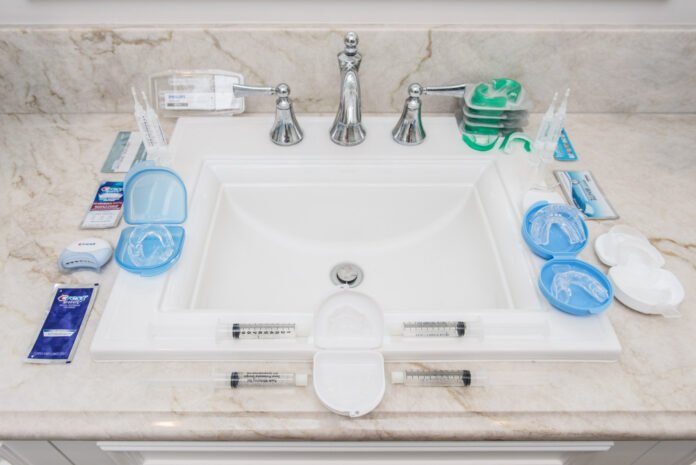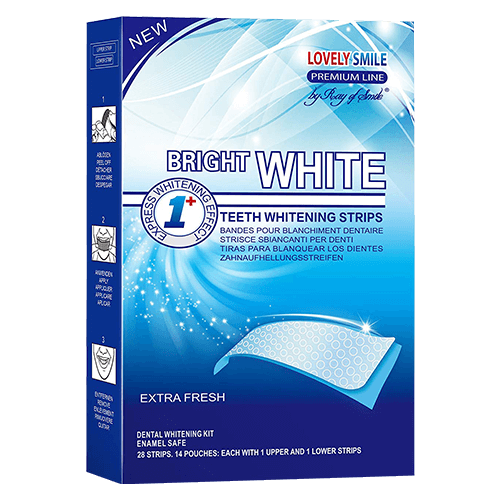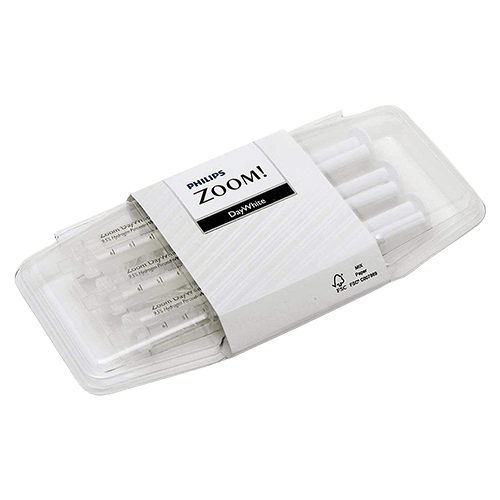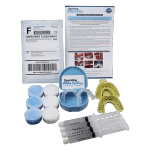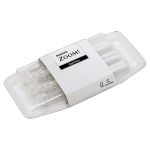The Best Teeth Whitening Kits: Brighten Your Smile at Home
A bright, white smile can boost your confidence and enhance your appearance, but professional treatments can be expensive. That’s where at-home teeth whitening kits come in! Offering a convenient and affordable way to achieve a whiter smile, these kits are designed to remove stains and give your teeth a fresh, radiant look. In this post, we’ll highlight the best teeth whitening kits available today, covering everything from fast-acting options to gentle, enamel-safe formulas. Say goodbye to stains and hello to a dazzling smile from the comfort of your home!
Compare the best teeth whitening kits
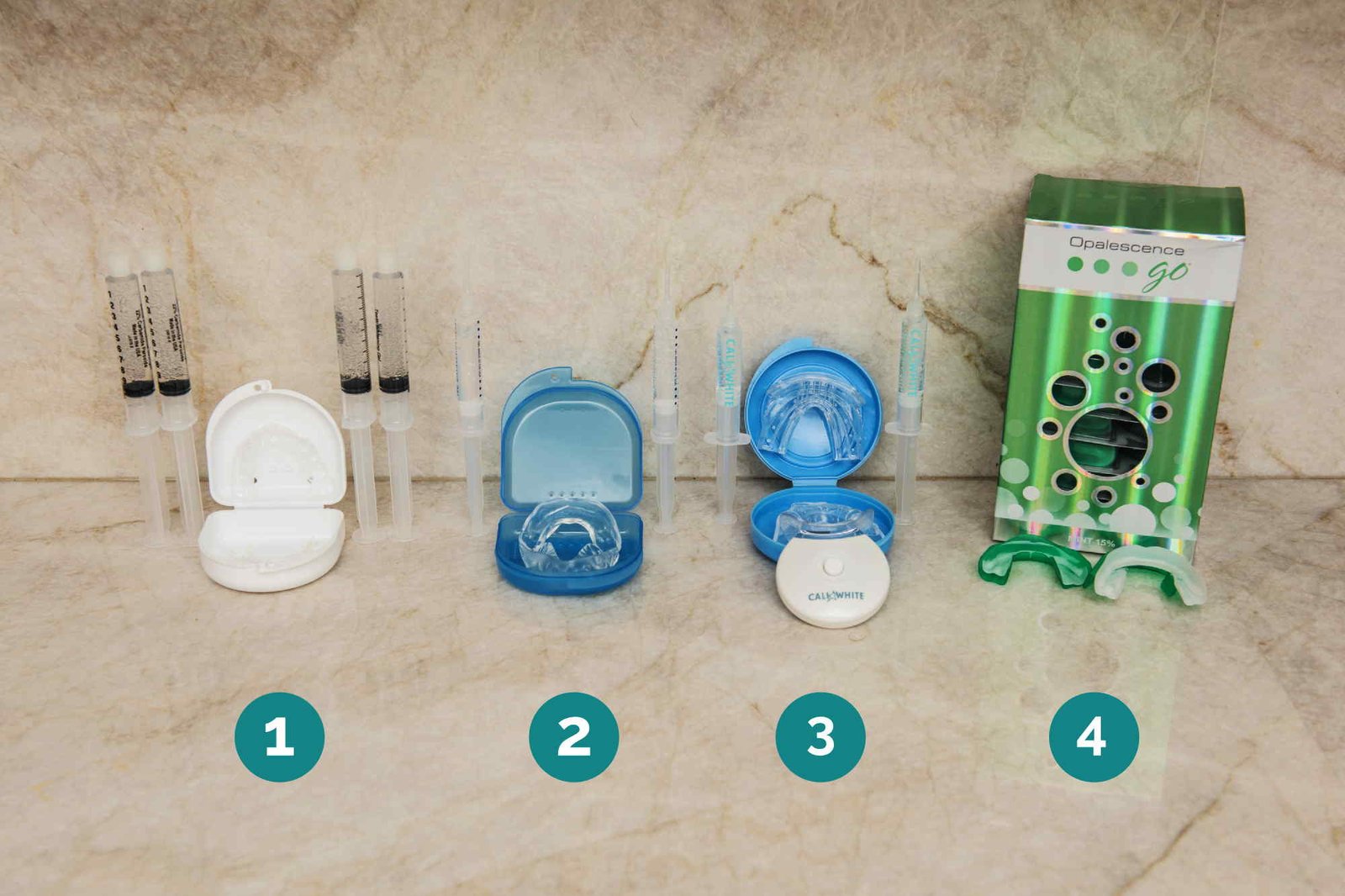
| Whitening Kits | Price | Strength (% H2O2 or equivalent) | Treatment Applications | Easy of Use |
|---|---|---|---|---|
| Whitening Trays | ||||
| 1. Sparkling White Smiles – Custom Tray System | $$$ | 7 | 60 | ☆☆☆☆ |
| 2. AuraGlow – Radiant Effects Teeth Whitening Kit | $ | 12 | 20 | ☆☆☆ |
| 3. Cali White – Deluxe Whitening System | $$ | 12 | 20 | ☆☆☆ |
| 4. Opalescence – Go | $$$$ | 15 | 10 | ☆☆ |
| Whitening Strips | ||||
| 1. Lovely Smile – Bright White | $ | ? | 14 | ☆☆ |
| 2. Solimo – 10-day kit | $ | ? | 10 | ☆☆ |
| 3. Crest – 3D White Glamourous White | $$ | ? | 14 | ☆☆ |
| 4. Lumist | $$$$ | 6 | 5 | ☆☆☆ |
| 5. Crest – 3D White with Light | $$$ | ? | 7 | ☆☆ |
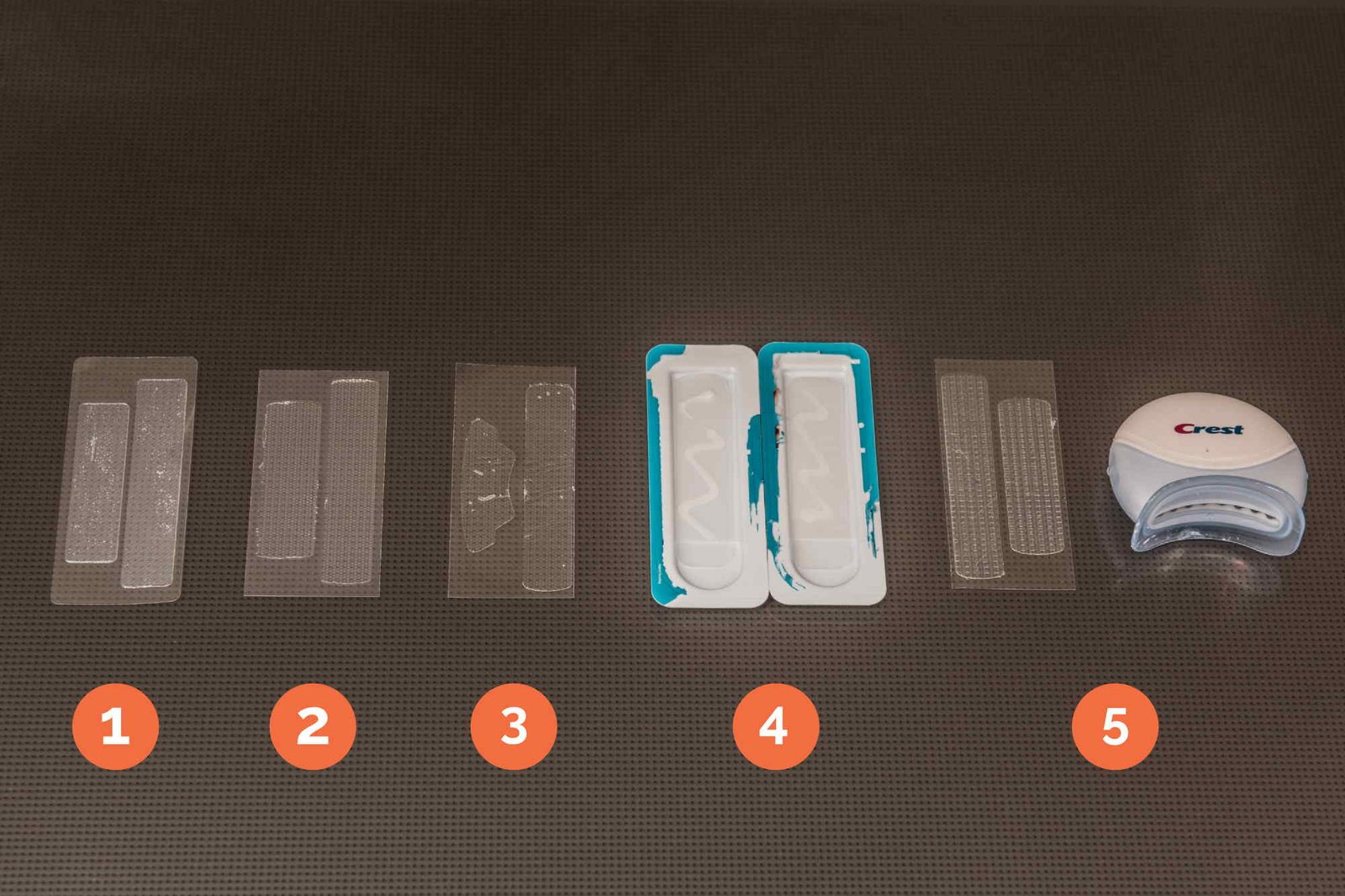
1. Best fit: Sparkling White Smiles – Custom Trays

The Sparkling White Smiles – Custom Tray System is a professional-grade whitening setup at a price that’s almost impossible to beat. For about the same price as a few boxes of Crest – Whitestrips, you get truly custom-crafted whitening trays and a generous supply of carbamide peroxide gel.
If you’ve ever had orthodontic work done, you probably know the teeth impression procedure: A dental assistant has you bite down on a plastic tray filled with silicone putty, then after the putty solidifies they send away the impressions to make castings of your teeth. After that, they can more easily make dental devices that fit the exact shape of your teeth.
Lab-made whitening trays use exactly that same procedure, but in the age of next-day shipping, you can get trays made without an office visit and at a much lower price. Yes, you have to mix the putty yourself, but that’s one of the few differences between this kit and getting trays made at the dentist.

Mixing and molding the impressions of your teeth with the included putty is a straightforward procedure, and the instructions included are thorough. The two pieces of putty are a little bit firmer than silly putty, and the colors make it easy to see when you’ve mashed them together long enough to mix. You then have a few minutes to press your teeth into the putty with the provided tray and wait for it to harden.
If you have difficulty making one set of impressions, Sparkling White Smiles includes enough putty to make one extra impression, and they’ll walk you through the process if you run into major trouble.
Sparkling White Smiles – Custom Tray System
If you want a perfect fit from the trays that are about to become such an intimate part of your oral health routine, custom-made trays from a lab are the best choice. After you send in your impressions these trays will get back to you in a few weeks, and then you’ll have a complete at-home whitening setup just like your dentist would sell you.
Once you make your impressions, drop the trays and address form in the mail and your completed trays will be mailed back to you in two weeks. If you’re in more of a hurry than that, Sparkling White Smiles also offers rush shipping for $22. You have to include a check or credit card info for express service or spare trays.
You can also order a custom-fit soft night guard that’s thicker than the whitening trays for an extra $46. The whitening trays are thin, so if you’ve got a major teeth-grinding problem, you might want to shell out for the dedicated guard. $46 isn’t cheap, but this is still much less than paying most dentists to have a guard made.
The rest of the kit
Based on the trays alone, the relatively high cost of the Sparkling White Smiles – Custom Tray System might make the popular mold-it-yourself tray kits like AuraGlow a more obvious option. With enough gel for 50 treatments, though, the $80 we paid for this system was well worth it.
The gel included with the Sparkling White Smiles kit is 22-percent carbamide peroxide. That’s weaker than many popular kits, which isn’t a bad thing. Many dentists recommend concentrations as low as 10 percent for at-home treatment, with much longer treatment times to ensure maximum effectiveness. The instructions suggest treating for 30 minutes twice daily with this solution, which is more tray time but less risk of tooth pain than other systems.
Other manufacturers selling the same strength of product, like Opalescence, suggest up to two hours of treatment time with this strength of solution, but it’s best to consult your dentist if you have specific questions about finding the right treatment regimen for your teeth.
Key takeaways:
- If you want the very best at-home whitening system, Sparkling White Smiles – Custom Tray System gets you a professional fit for less than $100.
- Mailing in impressions of your teeth is an extra step, but that’s still a lot quicker than making two dentist appointments.
- The fit and feel of these trays is perfect, and taking impressions went smoothly.
- Sparkling White Smiles includes enough 22-percent carbamide peroxide gel for about 50 treatments.
2. Best whitening strips: Lovely Smile
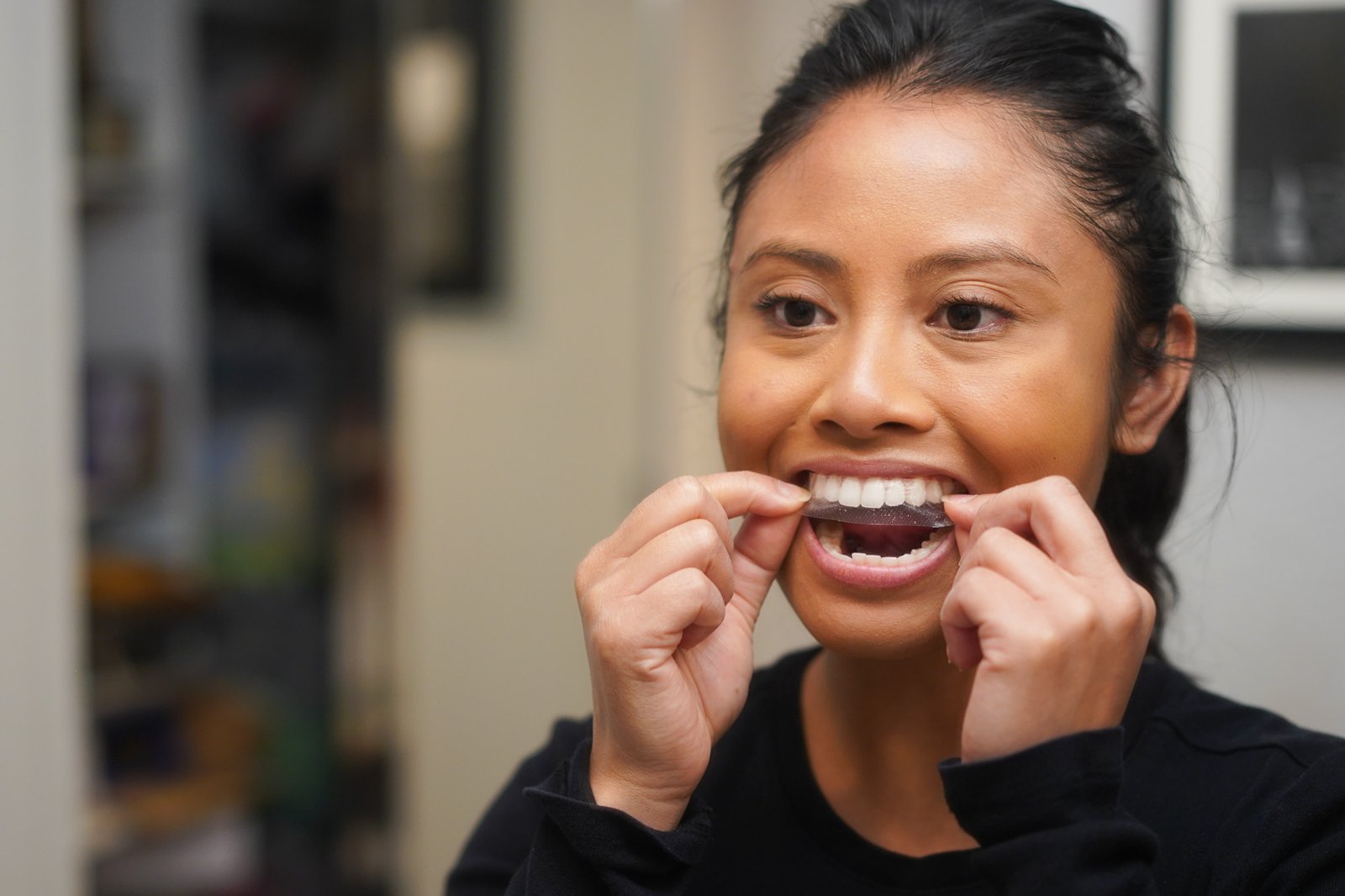
The Bright White strips from Lovely Smile are, as far as we can tell, identical to most other whitening strips on the market. The active ingredient is a small amount of hydrogen peroxide, and the strips themselves are thin and adhere well to teeth.
Lovely Smile suggests applying these thrips for 15 to 30 minutes during your first go, and for one hour per day after that. The kit contains enough strips for two weeks of whitening treatments, the same treatment length as Crest Whitestrips.
As we hope has been made clear, there’s no way to say exactly how effective any particular treatment will be for your teeth, but these strips are a low-risk way to start.
As with any whitening strips, the biggest problem is applying them carefully and evenly. It seems the peroxide in these strips is weak enough that they’re not likely to cause any harm, but you wouldn’t want to stick them to your gums every day. If you do find your gums sensitive after using strips, the irritation is temporary and should go away quickly.
Some dentists recommend trimming whitening strips so that they’re only a wide as you need to cover your most visible teeth, since nobody can tell how white your molars are. Excess strip material means more chance it’ll be touching your gums or even the roof of your mouth on the inside. The Lovely Smile strips are as easy to trim as the other brands are, and it’s reassuring that the pieces you’re throwing away aren’t as expensive.
Best Whitening Strips: Lovely Smile – Bright White
These economically-priced strips are a good way to see if you can handle applying whitening products to your teeth every day. Hydrogen peroxide is a proven ingredient for strip-based whitening, and the menthol helps you know if you’ve applied them correctly.
The only drawback to Lovely Smile strips in particular is the hour-long recommended treatment time: strips are pretty easy to get used to compared to trays, but by the time an hour is up you’ll be ready to get them out of your mouth. The Crest – Glamorous White and Solimo strips have instructions for half-hour treatment times.
A tingle from the menthol additive in these strips is also a good indicator that you’ve started dissolving the gel in your saliva or that it’s stuck to your gum tissue instead of your teeth.
When you’re done with your daily hour of strip-wearing, you’ll definitely want a place to rinse and brush your teeth. A paper towel works in a pinch to wipe the gel off, but it’s very sticky stuff. Most of the strips we tested were the same in this regard.
The drawbacks of whitening strips
As with any product like this, the sticky gel on the Lovely White strip has to touch your tooth enamel to whiten it. If you’ve got irregular teeth that overlap or otherwise prevent even contact, strips could inadvertently whiten only some parts of your teeth. Trays are a much better way to go in that case.
If you want the assurance that comes from the American Dental Association seal of acceptance, you’re going to have to spend about double the price of these strips to get the guarantees of Crest’s famous white strips. The results you get from the Lovely White strips should be the same.
Key takeaways:
- Lovely White – Bright Smile whitening strips are basically the same as most other whitening strips, but they don’t cost as much.
- The recommended course of treatment for these strips is an hour per day, and you get 14 treatments in the box.
- Strips aren’t the quickest method of treatment, but the risk is low, and most people get good results with them.
- If you have overlapping teeth or other obstacles to good surface contact, skip strips.
3. Speedy results: Philips – Zoom Day White
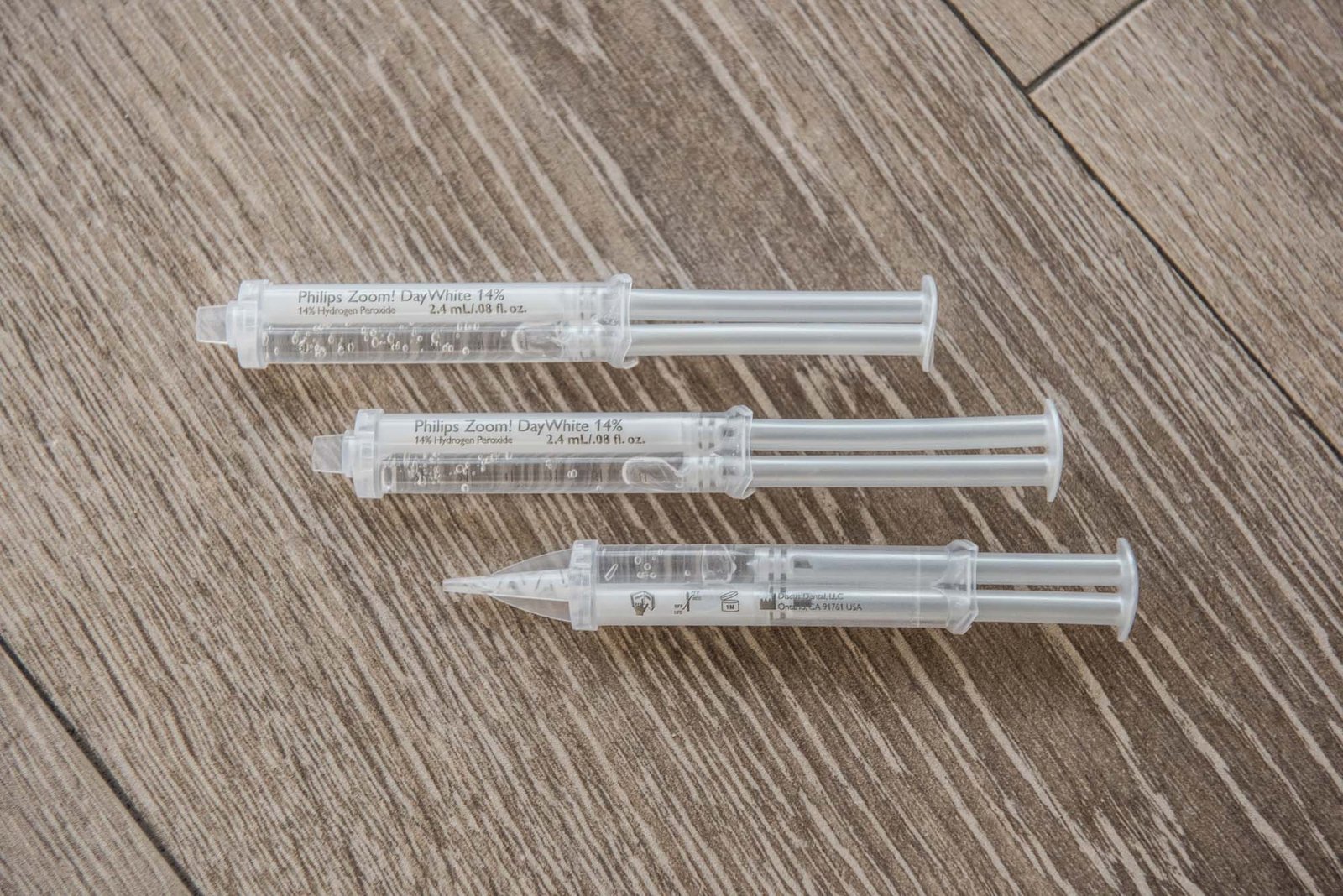
If you’re turned off by the lesser-known brands recommended above, you’re in luck: You can buy the same whitening products online that your dentist will sell you, usually at a much lower cost. Our pick is the Philips – Zoom Day White system. This product doesn’t come with trays, but that’s easy to address with off-the-shelf heat-molded trays like this affordable set from Nova White.
Zoom is a whitening system that’s been used by dentists since the 1990s. Philips bought Zoom from Discus Dental in 2010, and it’s now one of the top systems used in dental offices.
We picked Zoom over other high-concentration formulas for two reasons.
First, Philips uses hydrogen peroxide rather than carbamide peroxide, and it should work better in short treatment sessions for most people than the equivalent concentration of carbamide peroxide.
Second, Philips includes a remineralization and sensitivity-fighting formula in this package. Potassium nitrate is the same active ingredient used in sensitivity-numbing toothpaste, and Amorphous Calcium Phosphate (ACP) should help restore the surface of your tooth enamel.
Yes, you can get these sensitivity treatments in a toothpaste, but if you’re already spending half an hour every day putting fancy goop on your teeth, why not kill two birds with one stone?
Even buying it on Amazon, Zoom isn’t exactly a bargain. Compared to the rock-bottom price of 47 cents per treatment when you’re buying generic carbamide gel and heat-molded trays, or a cost of $1.60 per treatment for the perfect fit you get with the Sparkling White Smiles kit, the $3.87 per-treatment cost of the Philips system (including a $10 for a separate set of trays) is steep. But it’s comparable to the cost of some popular all-in-one kits, and you’re getting sensitivity treatment along with the higher-strength whitening solution.
For Quick Results: Philips – Zoom Day White
Hydrogen peroxide works a bit faster than the carbamide commonly sold in other kits, and Philips includes all the fancy additives to help keep sensitivity from ruining your whitening experience. If you’re looking for the fastest results you can get without booking an expensive hyper-bleach at your dentist, this is a good alternative.
The downside to buying professional-grade whitening gel on the internet is that these items aren’t actually intended to be sold direct-to-consumer. That is, they’re intended to be sold to you by a dentist, not by a dental supply warehouse running an Amazon store.
This whitening gel is designed for at-home with the guidance of a dentist, and the instructions are written that way. Also, Philips won’t give you a refund as Crest will if you aren’t happy with your results.
That said, 14-percent peroxide is still low compared to the products dentists will use for one-day whitening treatments. This stuff will sting if it gets on your gums, but it’s not dangerous unless you put it in your eye.
4. Affordable, high-quality trays: NovaWhite
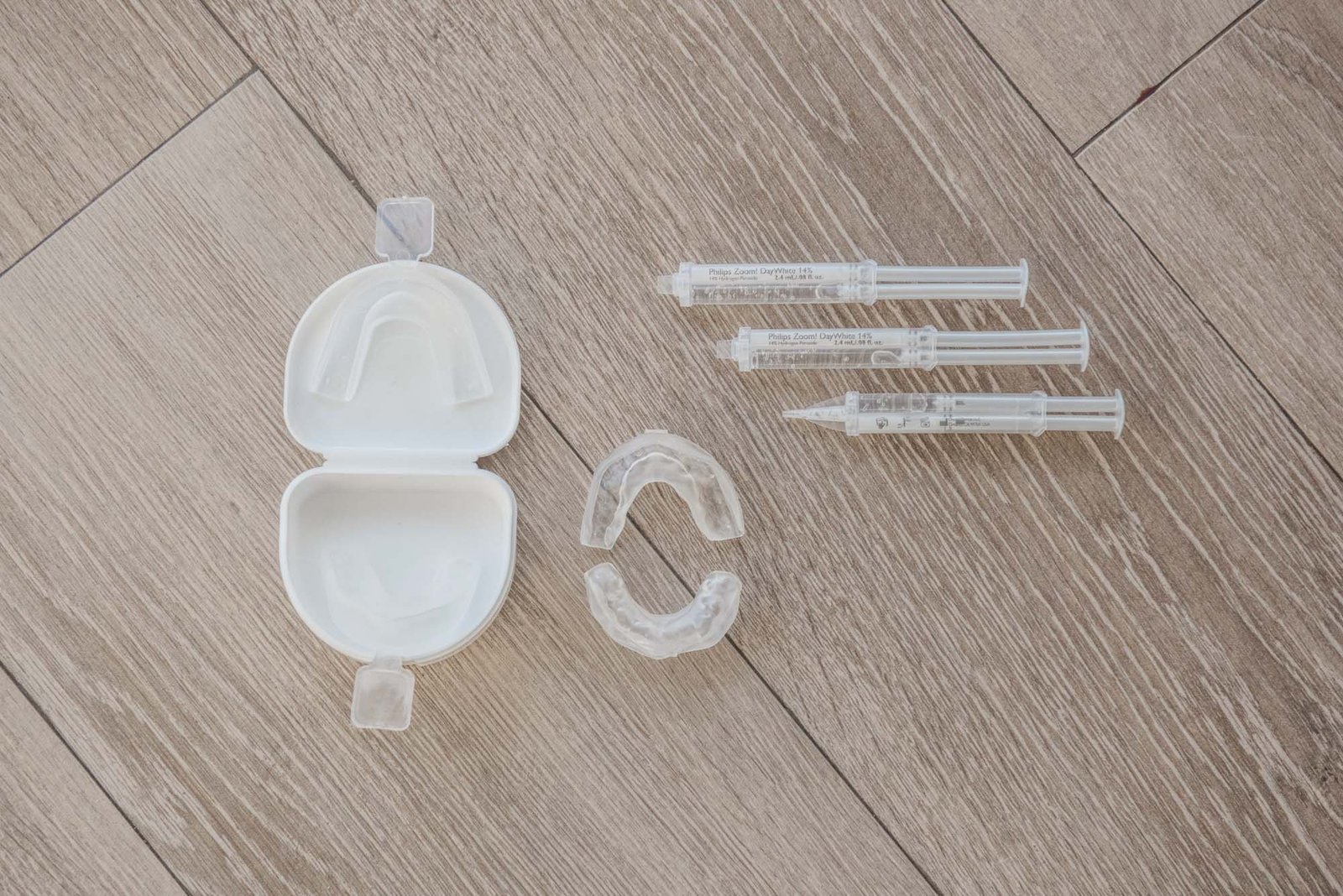
If you’re buying the Philips – Zoom gel by itself, you’ll also need trays. This is the trickiest part of at-home whitening: Heat-molded trays included in most kits are good enough, but they’re not foolproof.
Our pick for a stand-alone tray to go with Zoom refills is the NovaWhite heat moldable trays: They conform very well to your teeth and they’re a bargain at less than $10 for a set of four.
That said, the NovaWhite trays do curl over just a bit more quickly when you’re heating them in hot water than some of the other trays. We found these to be excellent trays for a low price, but plan on shaping both pairs of trays to get the best fit, and follow the instructions about heating time carefully.
Key takeaways:
- If you want to use name-brand whitening gel like your dentist will sell you, Philips – Zoom Day White is one of the best.
- Philips tempers the strength of this 14-percent peroxide solution with sensitivity-fighting potassium nitrate.
- There’s also a calcium-restoring gel in this solution
- Zoom also comes in lower concentrations, but this is our pick for a fast-acting whitening solution.
The other finalists we tested
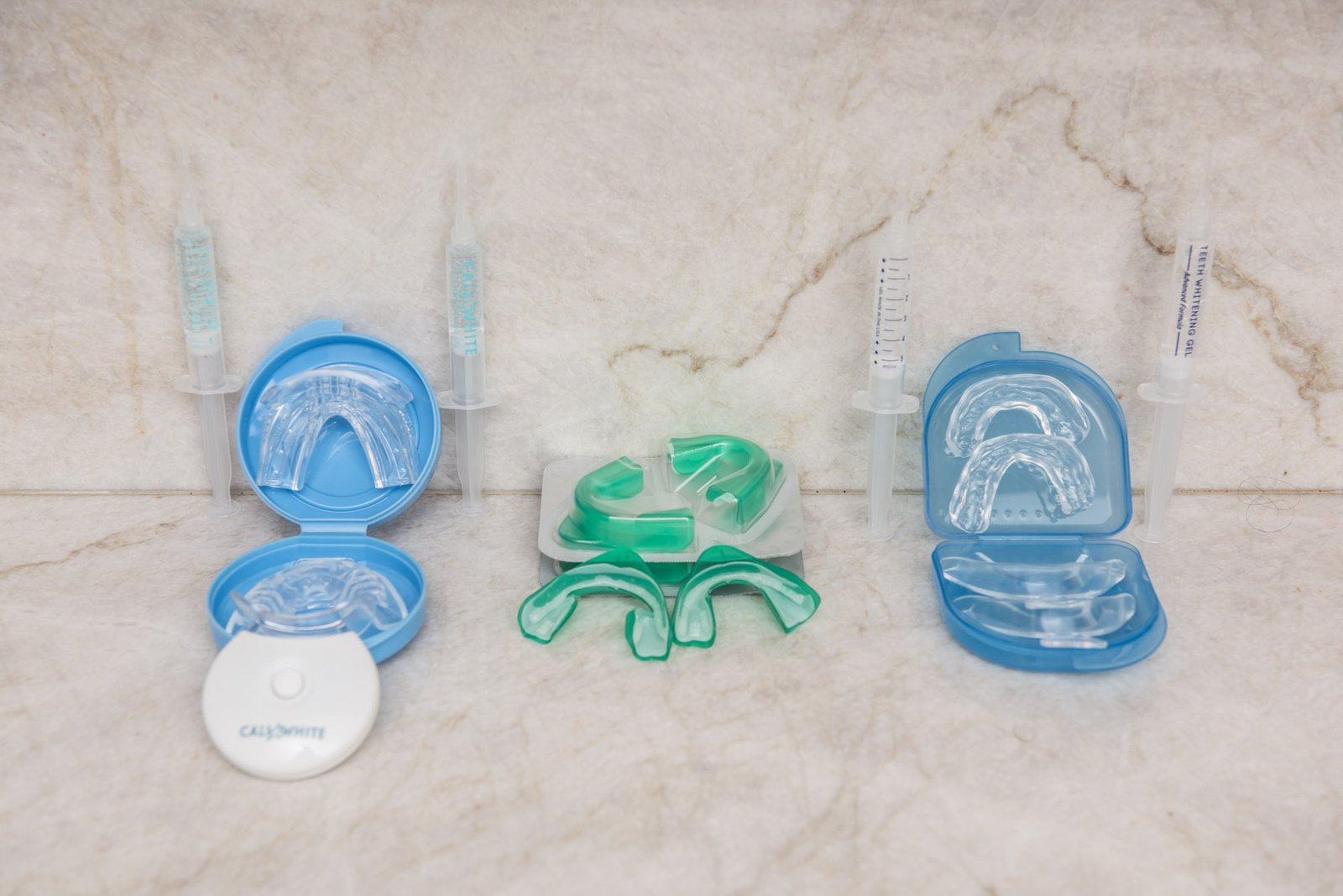
AuraGlow – Radiant Effects
If you want a complete kit that provides good value, the AuraGlow – Radiant Effects whitening kit is popular for a reason. The trays included in this kit were a little bit easier to heat and mold than most, with good instructions that resulted in a good fit the first time with no tweaking necessary.
After making seven complete sets of kits, we rank this set close to the top. AuraGlow’s trays give you a little more leeway when you’re trying to decide if it’s time to pull them out of the water. The tray material doesn’t just curl over and stick to itself if it’s in the hot water two seconds too long.
Your results may vary, of course, with do-it-yourself heat-molded trays. That’s why we picked the Sparkling White Smiles – Custom Tray System as our top choice. The thicker, softer plastic of the NovaWhite trays also felt just a little bit tighter overall once we tweaked them with a re-heat and a second attempt at getting a perfect fit.
The gel that comes with the AuraGlow kit isn’t any worse than what comes with the Sparkling White Smiles kit; it’s a bit stronger, but you should be careful about keeping it off your gums either way. At $1.50 per application, this set is about half the cost of buying Philips – Zoom refills and a set of trays, without any of the fancy additives included there.
Compared to the cost of the very least-expensive products available, like SensAllis gel refills and Nova White trays, this kit looks more expensive. Buying the most economical supplies comes out to one third the price-per-application of an AuraGlow kit, though you might never use up all that gel.
On the whole, the AuraGlow kit makes the most sense if you intend to stop whitening after using the one month of included treatments. A month of 35-percent carbamide should theoretically get you all the improvement you’re likely to see, but results vary.
Cali White – Deluxe Whitening System
If you just have to have a selfie with an LED light for your Instagram story, the Cali White – Deluxe Whitening System is the LED-bundle kit we’d pick over the others we checked out.
For about $5 more than AuraGlow’s kit, Cali White includes a universal-fit tray, which is actually much more awkward than it looks. The included heat-moldable trays are practically identical to the trays included with AuraGlow’s kit, and you get the same amount of carbamide peroxide gel.
Cali White goes out of their way to promote the benefits of baking soda, cranberry seed extract and aloe in their whitening gel, but it’s still carbamide peroxide doing the work.
The LED light included is kind of neat, but so far as we can tell it doesn’t speed up whitening in any way. We tried it, and it’s more annoying than it could possibly be worth.
Overall, the Cali White kit isn’t a bad buy for the trays and peroxide gel, but there’s no reason to pick it over the AuraGlow system.
Opalescence – GO
The take-home universal-fit Opalescence – GO system is unique in that it offers many of the advantages of both tray systems and whitening strips.
This product includes a universal-fit tray that’s pre-filled with Opalescence hydrogen peroxide gel, but it’s a moldable wax tray. You put the plastic holder over your teeth, squeeze the tray to fit just right, then remove the plastic.
Sadly, this isn’t as easy as it sounds. The trays are quite large to fit a wider range of mouth sizes, which means you need to carefully judge how far up and back to move them before you can squeeze them into shape.
These trays have far more gel than we’ve seen suggested by any filling instructions in other kits — there’s even gel for the inside of your back molars, just in case your date is shining a flashlight into your mouth.
You’re squeezing gel around as you mold the tray to fit your teeth, and this is Opalescent’s thick glue-like gel, not the watery stuff most kits come with. It’ll stay in place fairly well, but it’s not as easy to wipe off your gums.
Once you get the hang of how these trays work, they can be made to fit very well. Opalescence is popular with dentists, so if you have questions about strength or timing your regular dentist might be more likely to give you advice. It’s not as comfortable using this system as strips or custom-made trays, but it’s better than non-molded trays.
On the whole, we’re not sold on the value of this product. It’s not really harder to learn how to fit a heat-molded plastic tray than these waxy trays, and this product is far more expensive than anything else we tested.
At nearly $6 per set of trays, the best reason to go with this system is if you want to share a package with someone for a quick week of touch-up whitening, or you really hate the idea of squeezing hot plastic into your mouth.
Other whitening strips we tested
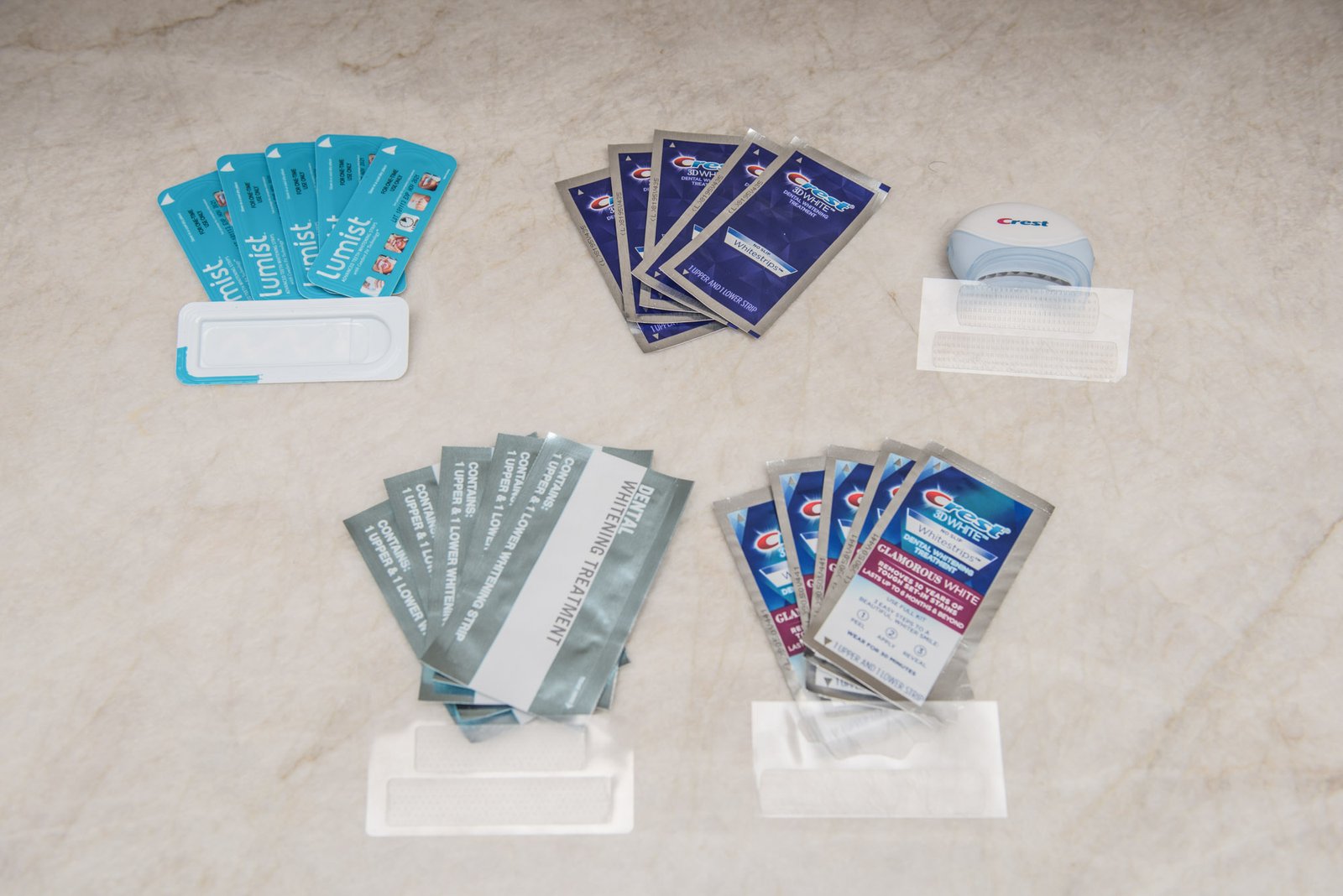
Solimo – 10-day kit
Direct from whatever factory makes all of these strips for everyone, Amazon brings you their Solimo-branded 10-day whitening kit. With the same active ingredients as Crest – 3D White Whitestrips and the slightly less-expensive Lovely Smile strips, the main reason to pick this set would be if the Lovely White 14-pack is out of stock. The differences between the products are minimal.
Crest – 3D White Whitestrips
We tested both the 3D White Glamorous White and “With Light” packages, and the differences are, again, minimal. In our control test to check peroxide-bleaching activity, these strips gave very similar results on coffee stains. The main difference is the taller, narrower strip you’re given for your bottom teeth in the Glamorous White packages, and of course the $34 LED light.
Crest’s “With Light” package also comes with directions that suggest using the strips for a full hour, rather than Glamorous White’s half-hour. It’s possible that the hydrogen peroxide solution is weaker in the “With Light” package, but Crest might also be using the difference in directions to suggest better results from the more expensive kit.
The LED light from Crest, as in the other kits, showed no effect on the activity of the peroxide in a controlled bleaching test. It’s possible it could warm your teeth slightly, but it’s a very small and low-power light source.
The one edge Crest has over the other strip-type whitening kits is that they’ve spent a lot of money getting the necessary research in place to earn the American Dental Association’s Seal of Acceptance. While that doesn’t necessarily mean this system is better than other whitening products, it does mean that it has been proven to work safely in a lot of tests.
Crest (owned by Procter and Gamble) is the only consumer-sale whitening product manufacturer that has successfully applied for the Seal on a whitening product. They’re in a similar place to P&G’s Oral-B electric toothbrushes that we tested: This brand proven, but that doesn’t mean other brands are selling ineffective products. The ADA won’t tell us if a company has ever paid up and still failed to earn the Seal on an over-the-counter product.
Lumist
The whitening strips from Lumist are the most unique of all the strips we researched. Rather than have just a plastic backing on a sticky peroxide-carrying gel, Lumist makes their backing more formable and stretchy. You can mold these strips around tooth features that the other strips will just bubble and crease on, ironically making Lumist a more three-dimensional solution that Crest’s so-called 3D Whitestrips.
Lumist uses 20-percent carbamide peroxide in these strips, which makes them faster-acting than other strips and potentially as quick as a tray and gel solution. The price of the Lumist strips is the weak point, though; at $6 per treatment, they’re almost as expensive as the stronger and more comfortable-to-wear Opalescence – GO trays.
How we selected products to test
Teeth whitening products are, for the most part, re-packaged supplies made for dentists to use in-office or give to patients for home treatment under professional supervision.
The one whitening product that’s “accepted” for at-home use by the American Dental Association is Crest’s Whitestrips line, which is now in its second generation of products and branded “Crest 3D White.” This was an obvious place to start.
When we researched the most-purchased products, though, it’s pretty obvious that most people who want white smiles don’t mind buying at-home whitening products that aren’t formally approved.
Over-the-counter teeth whitening kits use low concentrations of peroxide and are not considered dangerous. The FDA does not regulate teeth whitening kits sold in the U.S. Of course, dentists are quick to point out the uncertainty that comes with this lack of regulation. Dentists have access to stronger whitening products and the training to use them safely.
Written reviews of whitening kits are typically vague about product recommendations, and we didn’t find any comparative reviews that assess kits against one another.
We did find lots of conversation about teeth whitening on the web. The conversation is mostly about how well whitening works, how quickly it works, and whether it’s safe to do at home. Subreddits like r/dentistry frequently discuss the pros and cons of at-home whitening.
We looked at the top-selling products available at local discount stores and on major online retailers, and after closely scrutinizing 35 different products and whitening systems, we bought 16 different products to test, including five kits, five types of whitening strips, three stand-alone tray kits and three whitening gel products not sold as kits.
Two of the highest-rated gels we bought, from Philips and Opalescence, are labelled for sale through a dentist but still designed for use at home.
After looking at the range available and talking to a dentist, we decided to test the most popular 35-percent strength in most kits to see if our tester had any sensitivity or other reactions. We also tried a few slightly stronger or slightly weaker solutions.
How we tested
There’s one major hurdle to testing whitening products: Everyone’s results will be different. No two smiles are alike, and you can’t know if the stains that you have will be as easy to remove as another person’s. We tested with a single subject who has mildly sensitive teeth and no cavities or gum problems.
That said, there’s a reason all of these products use hydrogen peroxide (and carbamide peroxide, which breaks down to become hydrogen peroxide) as their whitening agent. It’s been proven to work, and it’s predictable. Every whitening system designed for effective at-home use is based on peroxide bleaching.
We bought 13 different whitening products, and our tester used them over the course of three months, focusing mostly on differentiating ease of use rather than the effect of the active ingredients.
We tested the activity of the peroxide gels in a coffee-stain test to make sure that these kits aren’t including fake or watered-down supplies, but it’s impossible for us to say anything more conclusive than that about results.
Instructions
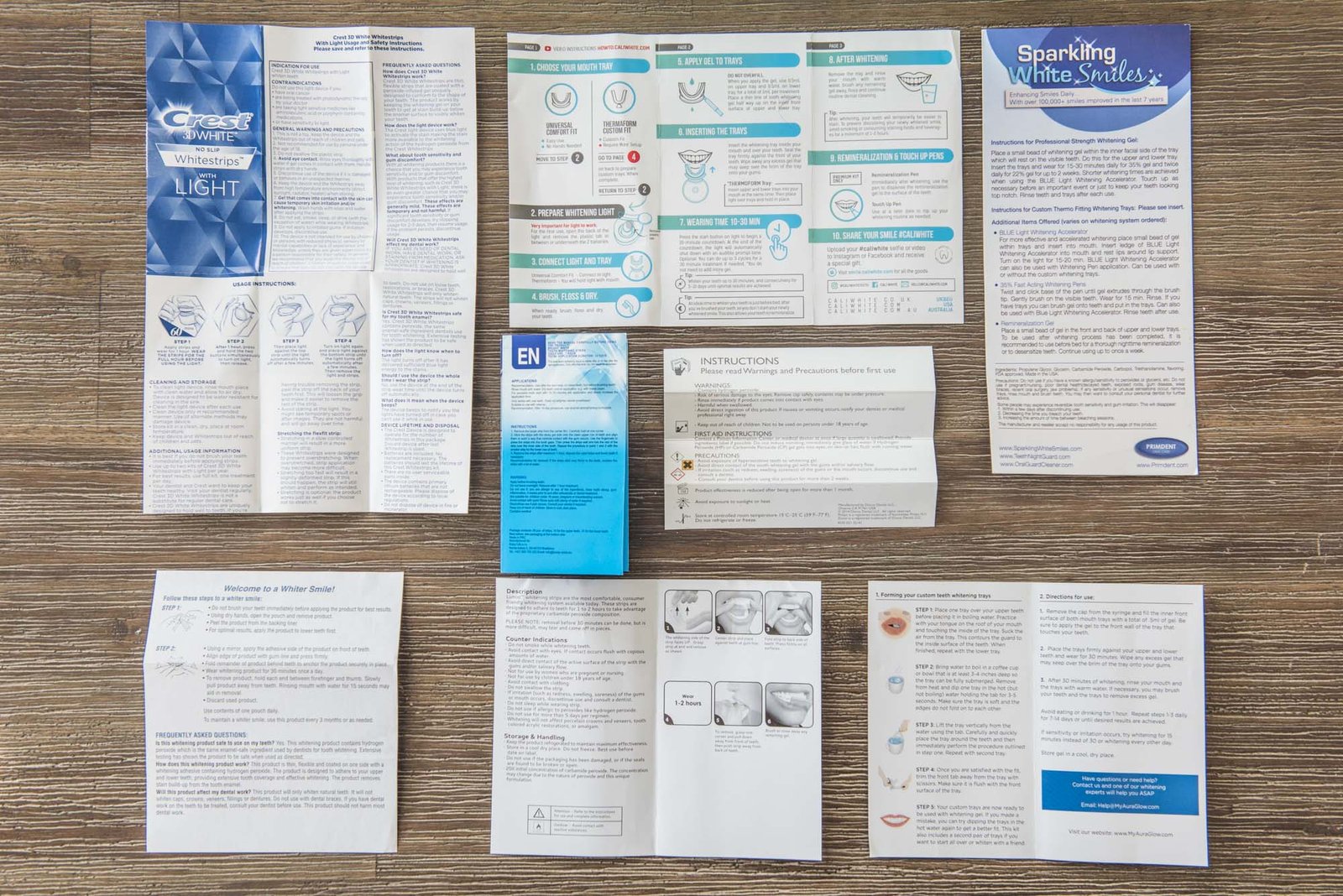
First, we laid out each kit and compared the instructions given. We found that the guidance from each product was similar, though some kits were definitely more thorough.
Instructions for shaping the mouthguard were almost always more detailed than instructions for applying the whitening product itself. Instructions for using whitening strips, which we admit are a fairly simple type of product to use, were almost non-existent.
We were expecting some clarification or guidance related to how long to use each product, but in most cases the recommended treatment times included wide ranges and seemed almost arbitrary. If you leave the bleach on your teeth longer, you’ll get more of an effect, but these suppliers are wary of making promises.
Standout instructions came with the Sparkling White Smiles – Custom Tray System, which is a good thing since a mistake mixing silicone putty and taking an impression could result in a wasted kit. Thankfully, Sparkling White Smiles also offers an extra tray’s worth of impression putty.
Ease of molding process
Timing is important with two-part silicone putty, since it hardens within a minute of mixing, but the heat-molded trays in the other kits required watching for signs that the walls were beginning to droop and acting immediately. One tray left in for a few seconds too long stuck to itself (like the instructions warned) and required a complete do-over.
Most kits include spare heat-moldable tray materials, just in case. Instructions for the kits were adequate, with no real stand-out winners. The timing for when to remove the tray from the hot water, when to put it in your mouth, and keeping all the edges from sticking together was surprisingly complex but manageable.
Fit and comfort
| Whitening Tray Kit | Fit and Comfort | Ease of Molding Process | Thorough Instructions |
|---|---|---|---|
| Sparkling White Smiles – Custom Tray System | ☆☆☆☆ | ☆☆☆ | ☆☆☆☆ |
| AuraGlow – Radiant Effects Teeth Whitening Kit | ☆☆☆ | ☆☆☆ | ☆☆☆ |
| Cali White – Deluxe Whitening System | ☆☆☆ | ☆☆☆ | ☆☆☆ |
| Opalescence – Go | ☆☆ | ☆☆ | ☆☆ |
Our tester used each tray-style kit to make impressions of his teeth. For most of the heat-shaped trays, the fitting process was repeated once or twice to get a comfortable and secure fit that wouldn’t leak whitening gel out or saliva in.
The trays from the Sparkling White Smiles lab were, of course, the best-fitting. The quality of fit from the shape-it-yourself trays was surprisingly good, despite our tester’s lack of experience with the process. Thinner material, like the AuraGlow and Cali White trays used, was easiest to shape.
We tested three other generic heat-formable whitening tray products to see if there was any difference between what’s included with whitening kits and other popular options. Nova White is the only company selling trays that are notably different, with thicker, textured plastic that curls rapidly if you let it get too hot. With some practice, the thicker plastic allows for an excellent fit.
Two kits we tested included universal-fit trays that don’t require heat-molding. Cali White includes this as an option along with two trays you can heat-mold, but the highly-rated MySmile – Teeth Whitening Kit only has a universal tray.
After trying two days of whitening with the giant trays, we don’t recommend them at all. This is definitely one-size-fits nobody, and for our tester, having a giant piece of plastic wedged in his mouth only led to uncomfortable half-hour sessions dealing with excessive saliva.
If heating the custom-fit trays scares you off, then whitening strips or the Opalescence – GO system are better options.
Bleach strength
We tested the strength of each solution on a piece of paper dyed with concentrated coffee.
The big surprise with this test is that whitening strips and some of the thicker gels are basically inactive unless they get wet. On dry paper, they had almost no bleaching effect at all. But after we washed the residue off the paper from the first test, we started to see bleaching in those areas.
The relative difference in activity between the different solutions, which range from an equivalent of 6-percent hydrogen peroxide up to 15 percent, was hard to see in this test. The difference in effect was more noticeable between thick and thin gel than it was between strong and weak concentrations.
Based on what we’ve read about the effects of peroxide bleaching on different people, it seems like a weaker solution over a longer period of time will have the best outcome. This means more time with the trays in your mouth, and also more days before you start expecting results, but usually less pain from sensitized teeth.
That said, the common 35-percent carbamide peroxide gel included in most over-the-counter kits is popular for a reason. You should see some results in a week, even with half-hour daily whitening sessions.
How to whiten teeth at home
Teeth whitening is very complex. Each person has different teeth and different stains, so it’s nearly impossible to say what success you’ll have with a particular whitening method. But the treatment itself is very simple, and the differences between products are minimal.
The ways that dentists will whiten your teeth are well-established. Dentists have been testing whitening treatments in their offices and with take-home kits for decades, and the methods haven’t changed much. The teeth whitening kits you can buy for yourself are, for the most part, the same thing you’d get from a dentist.
Whitening teeth involves bleaching built-up organic compounds like tannins from your teeth. This is more than just scrubbing a film off the surface: Whitening products actually remove stains from within the enamel.
Important features to consider
There are two compounds commonly used to achieve this bleaching: hydrogen peroxide and carbamide peroxide. Unstable oxygen-rich molecules in these compounds quickly break down many (but not all) stains.
The two molecules are so similar because about 35 percent of carbamide peroxide breaks down directly into hydrogen peroxide, so the bleaching action is basically identical. Carbamide is more stable in storage, which also makes it take longer to reach its maximum potential effect.
The big debate in teeth whitening is over the best way to evenly apply those peroxides to your teeth — and only to your teeth. Whitening strips stick a peroxide-laced gel onto the front of your teeth, while gel-filled trays can hold a stronger solution in place with a (low) risk of your swallowing it or burning your gums.
Toothpaste with peroxide can also help whiten teeth, though it’s in such a low concentration that you might never notice any gradual change.
Charcoal teeth whitener
Whatever you do, don’t try to scrub your stains off with an abrasive charcoal powder or use household cleaners in hopes of getting quick results. According to studies of popular products, charcoal teeth whitener toothpaste is usually abrasive enough to do more harm than good. Gentle natural-alternative tooth polishes can be fine as a detergent-free way to keep your teeth clean, but don’t sacrifice your enamel to get a whiter smile.
Types of home whitening kits
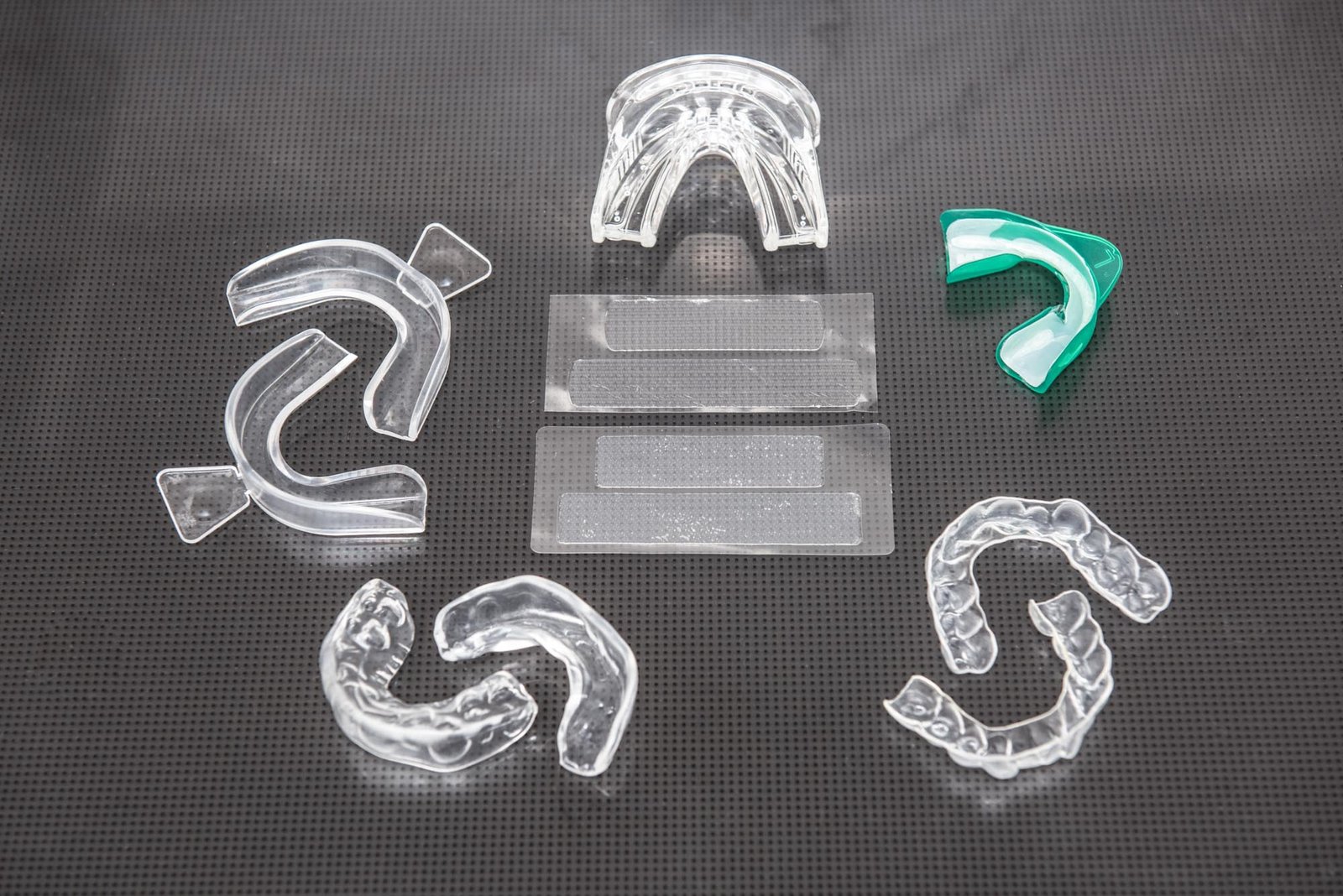
Whitening strips: The most basic and easiest type of whitening product, these strips of gel usually contain hydrogen peroxide and stick firmly to the surface of your teeth.
Trays: If you want to keep a stronger solution of peroxide in better contact with all your front teeth, a tray keeps it on your teeth.
There are four types of trays available:
Universal-fit trays: If you don’t want to go through the trouble of molding a tray to the shape of your teeth, this style will do the job and keep whitening solution or other dental products on your teeth, but they’re usually not comfortable to wear for more than a few minutes.
Heat-moldable trays: These trays are made from a heat-moldable EVA plastic (related to what’s in a hot glue stick.) When you heat the tray in almost-boiling water, it becomes soft enough to take an impression of your teeth, and you can usually get a perfect fit. Once it’s cooled, you could trim the tray if you want, but the plastic is quite thick. These trays will warp if you rinse them in hot water or leave them in the sun, and then they’d need to be re-molded to fit.
Custom-made trays: These trays are made by a dental service laboratory to fit exactly over plaster copies of your teeth, and excess tray material is trimmed back to the gumline. Your dentist’s office can make impressions of your teeth and handle the order, but we found many mail-order labs that will sell you a kit to make impressions at home.
Disposable Trays: This is a new type of product from Opalescence. Their GO system uses waxy, moldable trays that come pre-filled for full-coverage whitening without having to squirt any peroxide gel out of a tube.
Do whitening strips work?

Whitening strips are some of the most popular whitening products on the market, and for good reason: Starting with the introduction of Crest – Whitestrips in 2001, at-home whitening went from scary to dentist-approved.
The Crest line of whitening strips from Procter and Gamble is still the only at-home bleaching brand with the American Dental Association’s Seal of Acceptance. That means they’ve paid a lot of money to run patient trials to show that the product works as described and is safe.
One downside to whitening strips is that the peroxide-carrying gel isn’t able to fill in all the nooks and crannies of your smile: If you have overlapping or crooked teeth, the strips are likely to whiten the forward-facing parts and leave other parts untouched.
The other downside to whitening strips is that manufacturers use vague terms to describe the strength of what you’re buying. Percentages of active carbamide or hydrogen peroxide are always listed for gel-and-tray systems, but the concentration of active ingredients are rarely listed on whitening strips.
Who should avoid teeth whitening?
According to the ADA’s summary of clinical trials, sensitivity and gum irritation are the primary known side effects of whitening. These side-effects will subside, but for a weeks-long course of treatment you’ll want to know what you’re in for.
If you’ve got cavities, whitening could put hydrogen peroxide directly in contact with the nerves and blood vessels in your roots, so if you have any suspicion of decay, you should definitely get a check-up before whitening.
If your gums are irritated already — even just from eating something like popcorn — you’ll be more likely to feel a sting from the whitening gel if you get it on your gums. Some of the kits we tested recommend rinsing with salt water before a whitening treatment to determine if your gums will be hyper-sensitive to the peroxide.
Another warning we saw in whitening directions is about uneven whitening: Mineral deposits will not bleach at the same rate as the rest of your enamel. Likewise, if you’ve got veneers, partial prosthetic teeth or anything other than tooth enamel in your smile, whitening products will only bleach your real tooth surfaces.
Teeth whitening for sensitive teeth

The sad reality is that quick-acting whitening products are also more likely to make your teeth hurt. Studies have shown a 64-percent rate of complaint among patients with a fairly low concentration of 10-percent carbamide peroxide (or 3.6-percent hydrogen peroxide) which still takes 2 to 3 days of hours-long treatment to show any results.
When we asked officemates about their experiences with teeth whitening (whether at a dentist’s office or at home), we got similar feedback: Not everyone will have problems with tooth pain after whitening, but many people do.
According to Dr. Van Haywood, increasing the strength of the peroxide solution doesn’t give a linear increase in whitening performance, which means that doubling the strength won’t necessarily whiten twice as fast. But the effect on sensitivity does increase more directly, so if you’re trying out at-home whitening you’ll probably want to stick with a lower-strength product and plan to use it for longer.
The good news, is that you don’t sacrifice overall results with weaker solutions: Teeth will only whiten a certain amount with these treatments, so using extra-strong products just gets you there more quickly.
Many dentists will suggest a sensitivity-fighting toothpaste like Sensodyne, which contains fluoride and potassium nitrate, both of which have been shown in studies to help reduce sensitivity without reducing the effectiveness of whitening gels. We found suggestions on Reddit that you should start brushing with a sensitivity-fighting toothpaste (or massaging it into your teeth) even weeks before you start bleaching.
Some whitening gels we tested already have potassium nitrate and fluoride in the gel, including the two big-name products we tested: Philips – Zoom DayWhite and Opalescence – PF. The less-expensive all-in-one at-home kits did not have these ingredients.
Philips also adds a re-mineralizing “amorphous calcium phosphate” solution in their whitening gel that’s designed to help restore the surface of your teeth. This is the main reason we found to buy the more expensive whitening gel; in most other ways they’re identical to other carbamide or hydrogen peroxide solutions on the market.
If you want to stick to the more commonly available whitening products, you can still help reduce sensitivity with a specialized toothpaste containing stannous fluoride, potassium nitrate, Amorphous Calcium Phosphate (ACP) or Colgate’s proprietary “pro-argin” treatment. Sensodyne’s fluoride-and-potassium product is the best-known over-the-counter brand in the U.S., but ask your dentist about specialized products that might suit your particular sensitivity.
Nova-min is another compound that has worked very well in clinical trials, but after GlaxoSmithKline bought the rights in 2012, they’ve basically removed it from the North American market. You can buy Nova-min toothpaste from overseas, if you’re willing to pay a premium. Here’s an Amazon listing for the import Sensodyne formula.
Can you whiten teeth in one day?
Ideally, a tooth whitening system would work instantly. Few of us plan what we’ll look like at important meetings or in photographs much more than a week in advance, much less a month’s worth of hour-a-day treatments.
As we mentioned above, the downside to using stronger concentrations of whitening agents is sensitivity, but there’s another factor to remember: Whitening results vary, and you might not get any better result with an expensive in-office treatment than you would with a take-home kit.
If your dentist offers in-office “power bleaching” treatment, you’ll probably have access to the latest in light-activation tools and stronger concentrations of whitening product than you’d be comfortable using at home. If you really only have one day, a dentist will be able to give you reliable and safe results.
If you have the time, however, a long-term treatment should be just as effective (and much more affordable) than in-office options.
Does LED whitening do anything?
LED lights is the most polarizing part of over-the-counter whitening systems. It’s obviously an effective marketing strategy for companies like HiSmile and Express Smile Atlanta capitalizing on celebrity instagram endorsements.
Three of the kits we purchased included lights: Cali White – Deluxe Whitening System, MySmile – Teeth Whitening Kit and Crest – 3D White Whitestrips with Light.
Theoretically, these lights could possibly make a small difference by heating up the peroxide and drying out your enamel.
Note that the ADA does list the whole Crest – 3D White line as “accepted,” but they also clearly state that from their reviews of published research they don’t think light-activation makes a difference.
The lights included with over-the-counter kits aren’t even close to the equivalent of a light-activated treatment at your dentist’s office. Those machines use a laser or other high-wattage system, not 50 cents worth of cheap LED emitters. Even those expensive in-office light systems might not be making much of a difference, some studies show.

We tried these three LED systems for a few sessions, to be thorough, but then we tried some control tests on paper and an eggshell. Masking off part of the test surface with foil to see if the light was making a difference, our tests showed no change in whitening with the light, even after 10 repeated treatments.
Our tester was happy to put all the LED parts back into the boxes and go back to whitening with just trays and gel. Taking a selfie with a strange device hanging out of your mouth is kind of cute, but it’s awkward enough wearing just trays or strips every day.
After looking at research and actually trying the LED systems, we can’t help thinking this phenomenon is an elaborate prank.
The bottom line
Whitening your teeth at home is a bit like changing your own oil: it’s not for everyone, but nearly anyone can learn how to do it if they’re motivated. It’ll also save you some money.
For the best results, you want a set of plastic trays that will be comfortable to wear for a half-hour to an hour at a time. These trays should also conform exactly to your teeth, keeping the whitening solution on your enamel and off your gums.
The Sparkling White Smiles – Custom Tray System gives you the precision and quality of a tray your dentist could sell you, but without the overhead of paying for an in-office assistant to mix the silicone putty. Along with excellent trays, you get an all-inclusive package with enough whitening gel to last for months.
If $80 is more than you can afford to spend on whiter teeth, Lovely Smile – Bright White whitening strips will get you two weeks of basic treatment for less than $20. You can expect to see a basic improvement in shade with this system, and whitening strips are recommended by even the most cautious dentists.
If you need speedy results, we like the higher-concentration, fast-acting hydrogen peroxide offered in the Philips – Zoom Day White system. This solution comes with sensitivity-fighting and mineral-restoring compounds mixed in, so the extra sensitivity from faster-acting peroxide should be minimized. You’ll need to buy trays like these from Nova White separately, though.
For Perfect Fit: Sparkling White Smiles – Custom Tray System
This two-step kit has everything you need to have the same custom-fit whitening trays you’d get from your dentist’s lab shipped right to your door. The included whitening gel makes this package an even better bargain, though it’s already the lowest price we’ve ever seen for custom-made trays.

















